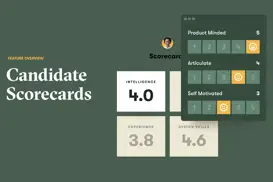How to Implement Candidate Scorecard Adoption
In the dynamic landscape of talent acquisition, the utilization of candidate scorecards has emerged as a pivotal strategy for companies striving to optimize their hiring processes. Aniday will delve into the concept of candidate scorecards, outlining how to implement candidate scorecard adoption effectively and highlighting the numerous benefits associated with their adoption.
What’s a Candidate Scorecard?
Candidate scorecards represent a structured evaluation tool used in the hiring process to assess and compare candidates objectively. They go beyond traditional methods, offering a comprehensive framework for evaluating skills, traits, and qualifications. This holistic approach ensures that hiring decisions are based on a standardized set of criteria, leading to more informed and unbiased choices.
Implementing a candidate scorecard can provide a number of benefits for organizations, including:
-
Elevated Objectivity in Hiring: The candidate scorecard guarantees impartial evaluation, mitigating personal biases, and ensuring fairness for all candidates.
-
Enhanced Efficiency and Cost-Effectiveness: By streamlining the hiring process, a candidate scorecard minimizes time and resource expenditure, optimizing the search for the right candidate.
-
Augmented Hiring Success: By pinpointing the most qualified candidates, a well-utilized candidate scorecard guides organizations towards optimal hiring outcomes for their open positions.
How to Implement Candidate Scorecard Adoption
To implement a candidate scorecard successfully, organizations need to follow a structured process. The following steps are a good starting point:
Step 1: Pre-implementation planning

Before diving into candidate scorecards, it is crucial to establish a foundation for success. This involves convening a meeting to align on overarching business objectives and ensure a cohesive understanding between hiring managers and recruiters. This step sets the stage for a collaborative effort throughout the implementation process.
Step 2: Needs Analysis
Understanding the specific needs of a role is fundamental to creating an effective candidate scorecard. This phase entails a thorough examination of the skills, traits, and qualifications essential for success in a specific role. By pinpointing these critical attributes, organizations can customize their evaluation criteria to precisely match the distinctive requirements of each position.
Step 3: Designing Candidate Scorecards

With a clear understanding of role requirements, the next step is the design of the candidate scorecard. This involves translating the identified attributes into a structured format that guides the evaluation process. The scorecard should be user-friendly, comprehensive, and aligned with the overarching goals of the hiring process.
The scorecard should include the following components:
-
A list of criteria that are relevant to the positions that the organization is recruiting for.
-
A description of each criterion, including the skills, experience, or qualities that are being evaluated.
-
A scoring rubric that specifies how each criterion will be evaluated.
Step 4: Deployment and Training
Once the candidate scorecard is crafted, it's time for implementation. This step includes deploying the scorecard in actual hiring processes and providing training to relevant stakeholders. Effective training ensures that everyone involved in the hiring process understands the scorecard's purpose, methodology, and how to utilize it efficiently.
Step 5: Monitoring and Evaluation
The implementation journey doesn't end with deployment; ongoing monitoring and evaluation are essential. Regularly assessing the effectiveness of the candidate scorecard, collecting feedback from stakeholders, and making necessary adjustments contribute to continuous improvement.
These are a few metrics that you can consider looking into:
-
The time it takes to hire candidates
-
The cost of hiring candidates.
-
The quality of the candidates who are hired.
Additional Tips for Successful Implementation
In addition to following the steps outlined above, there are a few additional tips that can help organizations implement a candidate scorecard successfully:
-
Be flexible: It is important to be flexible when implementing a candidate scorecard. The needs of the organization may change over time, so it is important to be prepared to make adjustments to the scorecard as needed.
-
Consistent Application: Apply the candidate scorecard consistently across all hiring processes. Use it as a flexible guide, considering each candidate's holistic profile and cultural fit.
-
Tech Streamlining: Explore tech solutions like ATS or evaluation platforms to streamline the scorecard process. Automation ensures consistency and provides valuable insights.
-
Feedback Loop: Seek feedback for continuous improvement. Use input from stakeholders to refine the scorecard, maintaining its effectiveness in the hiring process.
In Summary
A candidate scorecard is a valuable tool that can help organizations improve the efficiency, effectiveness, and fairness of their hiring process. Aniday's comprehensive guide, "How to Implement Candidate Scorecard Adoption," paves the way for organizations to seamlessly integrate a tailored scorecard aligned with their unique needs and objectives.
Aniday's HR Services
Headhunting Service
Find and recruit quality candidates in just 1 week! Supported by 40,000 experienced headhunters in IT, Finance, Marketing… capable of recruiting in any region.
Headhunting Service ➔Employer of Record (EOR) Service
On behalf of your business, we recruit employees and handle payroll without the need to establish a company in markets such as Vietnam, Singapore, Malaysia, India, Indonesia…
Employer of Record (EOR) Service ➔